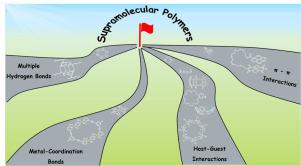Progress in Polymer Science ( IF 26.0 ) Pub Date : 2022-12-14 , DOI: 10.1016/j.progpolymsci.2022.101635 Hui-Qing Peng , Wenping Zhu , Wu-Jie Guo , Qingyun Li , Shixiang Ma , Christophe Bucher , Bin Liu , Xiaofan Ji , Feihe Huang , Jonathan L. Sessler

|
Supramolecular polymers are, in broad brushstrokes, self-assembled structures built up from small building blocks via the use of noncovalent interactions. In favorable cases, supramolecular polymers embody the best features of covalent polymers while displaying unique reversibility, responsiveness, adaptiveness, and stability. This has made them of interest across a wide variety of fields, from molecular devices to sensors, drug delivery, cell recognition, and environmentally friendly materials systems. This review is concerned with the determinants that underlie supramolecular polymer construction, specifically the driving forces that have been exploited to create them. To date, nearly the full range of known noncovalent interactions (e.g., hydrogen-bonding, electrostatic interactions, charge transfer effects, and metal coordination, among others) has been exploited to create supramolecular polymers. Typically, one or more types of interactions is used to link appropriately designed monomers. The choice of noncovalent interaction can have a significant influence on the structure and function of the resulting supramolecular polymers. Understanding the connections between the forces responsible for the assembly of supramolecular polymers and their properties provides the foundation for further advances in this fast-moving field. Given the above, this review will discuss recent progress in the rapidly advancing field of supramolecular polymers organized by the types of underlying interactions. An overview of future challenges and opportunities for supramolecular polymers, including their formation, characterization, and applications, is also provided.
中文翻译:

超分子聚合物:基于潜在相互作用类型的最新进展
从广义上讲,超分子聚合物是一种自组装结构,通过使用非共价相互作用由小的构建块构建而成。在有利的情况下,超分子聚合物体现了共价聚合物的最佳特性,同时显示出独特的可逆性、响应性、适应性和稳定性。这使得它们受到广泛领域的关注,从分子设备到传感器、药物输送、细胞识别和环保材料系统。这篇综述关注构成超分子聚合物结构基础的决定因素,特别是用来创造它们的驱动力。迄今为止,几乎所有已知的非共价相互作用(例如、氢键、静电相互作用、电荷转移效应和金属配位等)已被用于制造超分子聚合物。通常,一种或多种类型的相互作用用于连接适当设计的单体。非共价相互作用的选择会对所得超分子聚合物的结构和功能产生重大影响。了解负责超分子聚合物组装的力与其性质之间的联系,为在这个快速发展的领域取得进一步进展奠定了基础。鉴于上述情况,本综述将讨论按潜在相互作用类型组织的快速发展的超分子聚合物领域的最新进展。超分子聚合物未来挑战和机遇概述,































 京公网安备 11010802027423号
京公网安备 11010802027423号